Blog & Latest Updates
Fly Fishing Articles
Insects by Common Name


Insect Order Ephemeroptera (Mayflies)
Taxonomic Navigation -?-
Kingdom
Animalia (Animals)
» Phylum
Arthropoda (Arthropods)
» Class
Insecta (Insects)
» Order Ephemeroptera (Mayflies)
8 families aren't included.
Common Name
| Match | Common Name |
| Mayflies |
This is page 57 of specimens of Ephemeroptera. Visit the main Ephemeroptera page for:
- The behavior and habitat of Ephemeroptera.
- 67 underwater pictures of Ephemeroptera.
Pictures of 828 Mayfly Specimens:
Female Epeorus vitreus (Sulphur) Mayfly Dun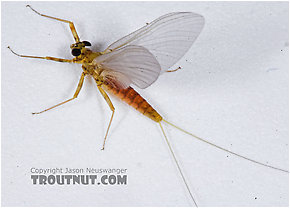 View 4 Pictures
View 4 Pictures
 View 4 Pictures
View 4 PicturesCollected June 8, 2005 from the Namekagon River in Wisconsin
Added to Troutnut.com by Troutnut on May 26, 2006
Added to Troutnut.com by Troutnut on May 26, 2006
Female Leptophlebia cupida (Borcher Drake) Mayfly Spinner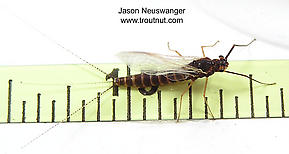 View 3 PicturesI'm not positive of the collection date on this one, so I'm guessing.
View 3 PicturesI'm not positive of the collection date on this one, so I'm guessing.
 View 3 PicturesI'm not positive of the collection date on this one, so I'm guessing.
View 3 PicturesI'm not positive of the collection date on this one, so I'm guessing.Collected May 20, 2004 from unknown in Wisconsin
Added to Troutnut.com by Troutnut on January 25, 2006
Added to Troutnut.com by Troutnut on January 25, 2006
Male Leucrocuta hebe (Little Yellow Quill) Mayfly Spinner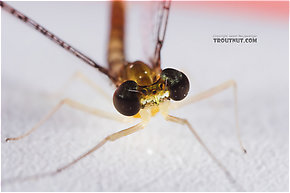 View 10 Pictures
View 10 Pictures
 View 10 Pictures
View 10 PicturesCollected June 5, 2005 from the Teal River in Wisconsin
Added to Troutnut.com by Troutnut on May 24, 2006
Added to Troutnut.com by Troutnut on May 24, 2006
Male Attenella delantala (Small Blue-Winged Olive) Mayfly Nymph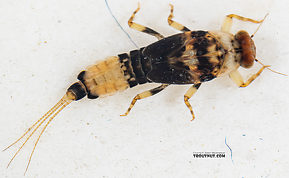 View 10 Pictures
View 10 Pictures
 View 10 Pictures
View 10 PicturesCollected July 25, 2019 from Mystery Creek #249 in Washington
Added to Troutnut.com by Troutnut on July 26, 2019
Added to Troutnut.com by Troutnut on July 26, 2019
Ephemerella (Hendricksons, Sulphurs, PMDs) Mayfly Nymph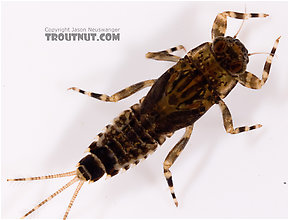 View 5 PicturesThe striking coloration of this Ephemerella nymph earned it a turn under the camera lens. It has a different look than others I've collected, but I still might tentatively guess it belongs to the widely variable (and ironically named) invaria species.
View 5 PicturesThe striking coloration of this Ephemerella nymph earned it a turn under the camera lens. It has a different look than others I've collected, but I still might tentatively guess it belongs to the widely variable (and ironically named) invaria species.
 View 5 PicturesThe striking coloration of this Ephemerella nymph earned it a turn under the camera lens. It has a different look than others I've collected, but I still might tentatively guess it belongs to the widely variable (and ironically named) invaria species.
View 5 PicturesThe striking coloration of this Ephemerella nymph earned it a turn under the camera lens. It has a different look than others I've collected, but I still might tentatively guess it belongs to the widely variable (and ironically named) invaria species.Collected April 14, 2007 from Cayuta Creek in New York
Added to Troutnut.com by Troutnut on April 22, 2007
Added to Troutnut.com by Troutnut on April 22, 2007
Drunella doddsii (Western Green Drake) Mayfly Nymph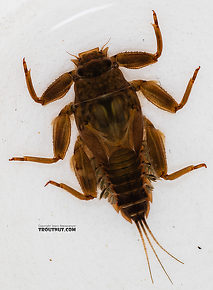 View 4 Pictures
View 4 Pictures
 View 4 Pictures
View 4 PicturesCollected July 2, 2019 from the Gallatin River in Montana
Added to Troutnut.com by Troutnut on July 18, 2019
Added to Troutnut.com by Troutnut on July 18, 2019
Male Maccaffertium ithaca (Light Cahill) Mayfly Dun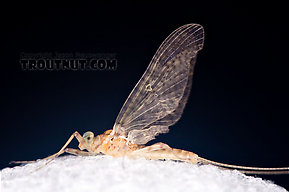 View 6 PicturesBased on the identical size, shape, and relative proportions of different body parts, I'm pretty sure this dun is of the same species as two spinners I collected at about the same time. The color is dramatically different, but that's to be expected with many of these species in the transition from dun to spinner.
View 6 PicturesBased on the identical size, shape, and relative proportions of different body parts, I'm pretty sure this dun is of the same species as two spinners I collected at about the same time. The color is dramatically different, but that's to be expected with many of these species in the transition from dun to spinner.
 View 6 PicturesBased on the identical size, shape, and relative proportions of different body parts, I'm pretty sure this dun is of the same species as two spinners I collected at about the same time. The color is dramatically different, but that's to be expected with many of these species in the transition from dun to spinner.
View 6 PicturesBased on the identical size, shape, and relative proportions of different body parts, I'm pretty sure this dun is of the same species as two spinners I collected at about the same time. The color is dramatically different, but that's to be expected with many of these species in the transition from dun to spinner.Collected June 7, 2007 from the West Branch of the Delaware River in New York
Added to Troutnut.com by Troutnut on June 8, 2007
Added to Troutnut.com by Troutnut on June 8, 2007
Ephemerella invaria (Sulphur Dun) Mayfly Nymph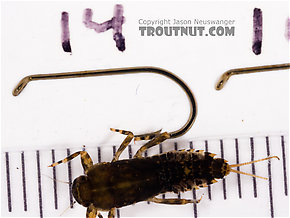 View 4 Pictures
View 4 Pictures
 View 4 Pictures
View 4 PicturesCollected April 1, 2007 from Mystery Creek #62 in New York
Added to Troutnut.com by Troutnut on April 3, 2007
Added to Troutnut.com by Troutnut on April 3, 2007
Ameletus vernalis (Brown Dun) Mayfly Nymph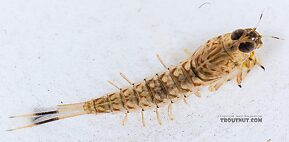 View 9 PicturesI keyed this one out using the Alberta species key from Zloty & Pritchard 1997.
View 9 PicturesI keyed this one out using the Alberta species key from Zloty & Pritchard 1997.
Notes from the ID include:
1. Posterior (Posterior: Toward the back of an organism's body. The phrase "posterior to" means "in back of.") margin of sternites (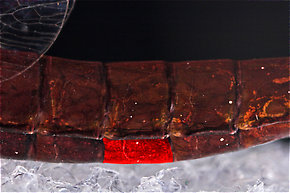 Sternite: The bottom (ventral) part of a single segment on an insect's abdomen.) 6-8 without spines
Sternite: The bottom (ventral) part of a single segment on an insect's abdomen.) 6-8 without spines
2. Mesal (Mesal: Toward the middle.) gill extension "well developed"
3. Basil third of caudal (Caudal: Toward the posterior tip of the body.) filaments pale
4. Anterior (Anterior: Toward the front of an organism's body. The phrase "anterior to" means "in front of.") surface of front femora (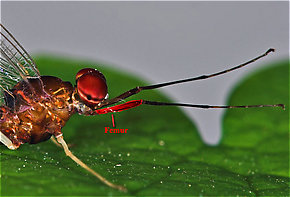 Femur: The main segment of an insect's leg close to the body, in between the tibia and the trochanter.) mostly pale
Femur: The main segment of an insect's leg close to the body, in between the tibia and the trochanter.) mostly pale
5. Dark band on caudal (Caudal: Toward the posterior tip of the body.) filaments begins around segment 20
6. Final instars (Instar: Many invertebrates molt through dozens of progressively larger and better-developed stages as they grow. Each of these stages is known as an instar. Hard-bodied nymphs typically molt through more instars than soft-bodied larvae.) early season
This one keys out pretty cleanly to Ameletus vernalis except the color pattern on the tergites (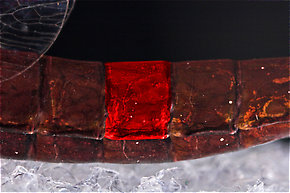 Tergite: The top (dorsal) part of a single segment on an insect's abdomen when it consists of a single chitinous plate (sclerite), or an individual sclerite if the segment has more than one.) doesn't match. However, two species known in Washington aren't included in the key. Of those two, Ameletus vancouverensis would be too small (adult body length 9 mm), but Ameletus andersoni (currently documented only from a spring in Cowlitz County) has a wide range of sizes and emergence times that could be compatible with this one. So I can't rule that species out, but Ameletus vernalis seems the most likely.
Tergite: The top (dorsal) part of a single segment on an insect's abdomen when it consists of a single chitinous plate (sclerite), or an individual sclerite if the segment has more than one.) doesn't match. However, two species known in Washington aren't included in the key. Of those two, Ameletus vancouverensis would be too small (adult body length 9 mm), but Ameletus andersoni (currently documented only from a spring in Cowlitz County) has a wide range of sizes and emergence times that could be compatible with this one. So I can't rule that species out, but Ameletus vernalis seems the most likely.
 View 9 PicturesI keyed this one out using the Alberta species key from Zloty & Pritchard 1997.
View 9 PicturesI keyed this one out using the Alberta species key from Zloty & Pritchard 1997. Notes from the ID include:
1. Posterior (Posterior: Toward the back of an organism's body. The phrase "posterior to" means "in back of.") margin of sternites (

One sternite of this Isonychia bicolor mayfly spinner is highlighted in red.
2. Mesal (Mesal: Toward the middle.) gill extension "well developed"
3. Basil third of caudal (Caudal: Toward the posterior tip of the body.) filaments pale
4. Anterior (Anterior: Toward the front of an organism's body. The phrase "anterior to" means "in front of.") surface of front femora (

The femur of this Isonychia bicolor mayfly spinner is highlighted in red.
5. Dark band on caudal (Caudal: Toward the posterior tip of the body.) filaments begins around segment 20
6. Final instars (Instar: Many invertebrates molt through dozens of progressively larger and better-developed stages as they grow. Each of these stages is known as an instar. Hard-bodied nymphs typically molt through more instars than soft-bodied larvae.) early season
This one keys out pretty cleanly to Ameletus vernalis except the color pattern on the tergites (

One tergite of this Isonychia bicolor mayfly spinner is highlighted in red.
Collected April 9, 2021 from the Yakima River in Washington
Added to Troutnut.com by Troutnut on April 12, 2021
Added to Troutnut.com by Troutnut on April 12, 2021
Male Baetidae (Blue-Winged Olives) Mayfly Spinner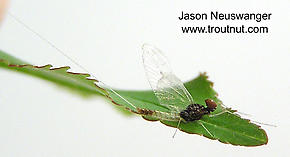 View 4 PicturesI love the shape of this guy's eyes.
View 4 PicturesI love the shape of this guy's eyes.
 View 4 PicturesI love the shape of this guy's eyes.
View 4 PicturesI love the shape of this guy's eyes.Collected May 24, 2004 from unknown in Wisconsin
Added to Troutnut.com by Troutnut on January 25, 2006
Added to Troutnut.com by Troutnut on January 25, 2006
Top 10 Fly Hatches
Top Gift Shop Designs
Eat mayflies.
Top Insect Specimens
Miscellaneous Sites
Troutnut.com is copyright © 2004-2024 Jason
Neuswanger (email Jason). See my FAQ for information about use of my images.
 privacy policy
privacy policy
